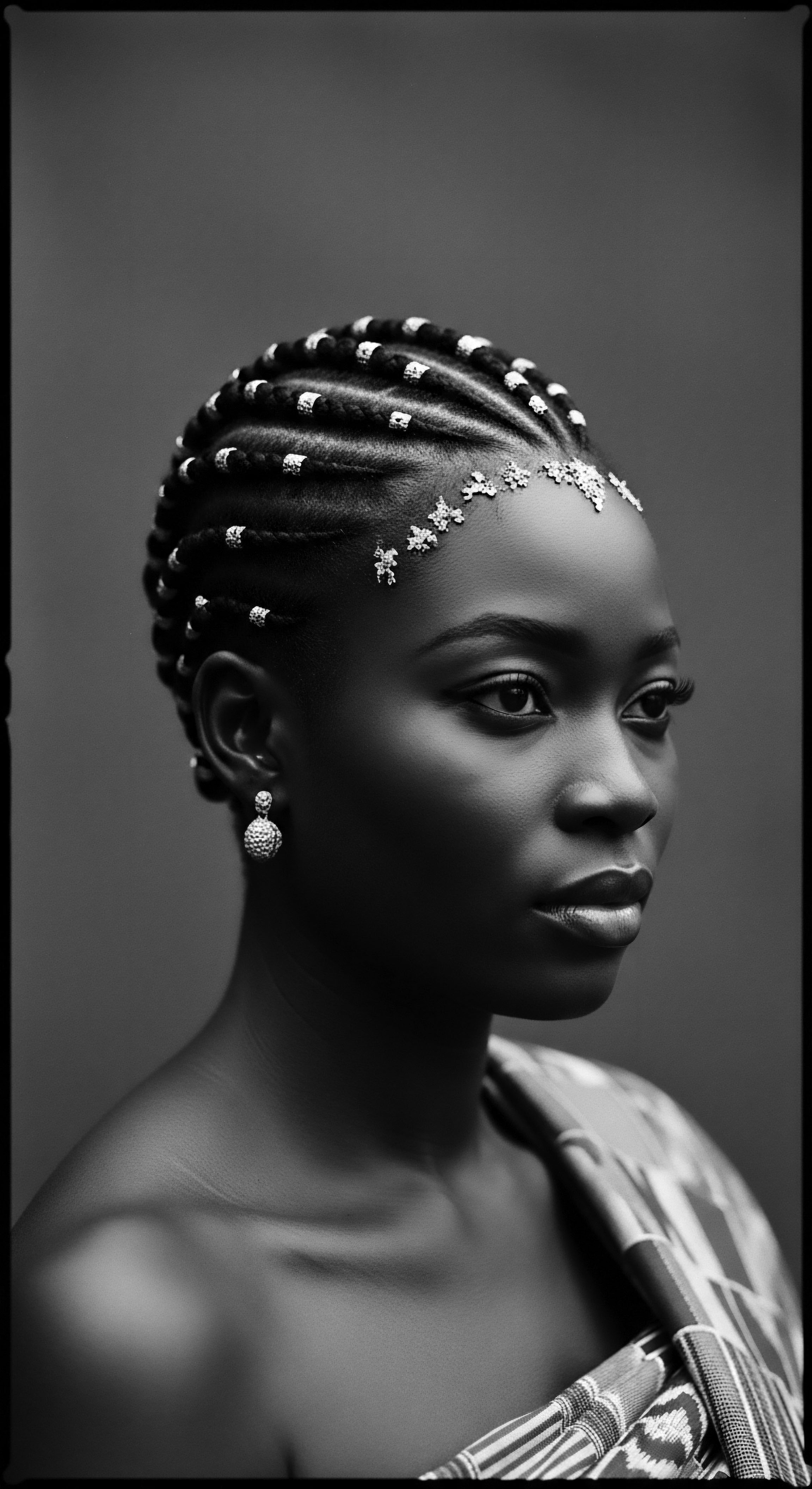
Roots
In the quiet corners of our collective memory, where ancestral whispers guide contemporary rhythms, lies the enduring spirit of textured hair. It is a living testament to heritage, a profound connection spanning generations and continents. For those of us who journey with curls, coils, and waves, our strands are not simply biological filaments; they are archives, each curve holding stories of resilience, artistry, and wisdom passed down through time.
To comprehend the arrival of Chébé, this treasured gift from Chad, into the expansive realm of modern textured hair care, we must first place our hands upon the earth from which it springs. We must seek understanding of the very foundations of these hair types, recognizing their deep history, their physiological particularities, and the ancestral lexicon that long defined their care.
The textured hair strand itself, viewed through the lens of history and science, presents a marvel of natural design. Unlike straight hair, which tends to be round in cross-section, textured hair often reveals an elliptical or flattened shape. This structural distinction, often tied to its helical growth pattern, contributes to the unique coiling and bending that defines its appearance. It is a configuration that, while providing splendid volume and intricate patterns, also possesses an inherent vulnerability to moisture loss and breakage.
Early ancestral communities, observing these characteristics with acute attention, developed sophisticated care practices. These practices, honed over countless generations, were not merely about appearance; they spoke to the very health and preservation of the hair, ensuring its vigor within often challenging climates.
The traditional understanding of hair anatomy in many African cultures transcended the purely physical. Hair was often seen as a conduit to the spiritual realm, a crown connecting the individual to their lineage and the divine. The care of hair, therefore, became a sacred act, a communal endeavor reflecting deep respect for self and community.
This reverence is particularly visible in the Basara women of Chad, whose long, strong hair is a hallmark of their identity. Their ancestral ritual involving Chébé stands as a prime example of this integrated worldview.
The lineage of textured hair care, including the enduring wisdom of Chébé, represents a deep reverence for heritage, far beyond simple aesthetic concerns.
The Basara women, guardians of the Chébé practice, reside in a region where the harsh climate presents considerable challenges to hair health. Their mastery of Chébé, cultivated over centuries, became a potent answer to dryness and fragility. It allowed them to grow their hair to remarkable lengths, often reaching the thighs, a phenomenon attributed not merely to genetics, but to the diligent application of this natural mixture. Chébé, at its core, is a powdered mixture made from specific botanical ingredients, notably the seeds of the Croton Gratissimus var.
Zambesicus plant. These seeds, along with mahllaba soubiane (cherry kernels), cloves, missic, and resin tree sap, are carefully prepared—harvested, sun-dried, roasted, pulverized, and sifted—to create the potent powder. This traditional preparation highlights a deep botanical understanding, a knowledge base accumulated through intimate observation of the natural world and its gifts for well-being.
The historical significance of Chébé within Chadian culture is not confined to individual hair growth. It extends to the realm of community bonding and identity. Hair care, in this context, is a social activity where women gather, share stories, and pass on traditions, reinforcing bonds of sisterhood and cultural continuity. This communal aspect stands as a powerful counterpoint to often individualistic modern beauty routines, highlighting a heritage where self-care is interwoven with collective well-being.

What Can Chébé Tell Us About Ancient Hair Care Practices?
The historical roots of Chébé are strikingly ancient, reaching back thousands of years. Salwa Petersen, a Chad-born founder of a Chébé-based hair care company, suggests the origins of Chébé could be at least 7,000 years old. She points to prehistoric cave paintings in the Guéra Massif mountains of Northern Chad that depict men applying Chébé, indicating a practice deeply embedded in the region’s distant past.
This evidence speaks volumes about the early ingenuity of African peoples in harnessing nature for personal adornment and well-being. Such findings remind us that the roots of modern hair science often find parallels, or even origins, in ancestral practices, a validation that resonates deeply with our understanding of heritage.
The classification of textured hair today often relies on numerical and alphabetical systems, like the widely recognized curl pattern types. While these systems offer a convenient shorthand for describing hair, they seldom carry the cultural weight or historical context found in traditional lexicons. In ancestral African societies, hair styling and care practices were often indicators of social rank, marital status, tribal affiliation, and even emotional states.
(Sieber & Herreman, 2000) For example, among the Yoruba people of Nigeria, specific hairstyles could signal a man’s readiness for war. (Byrd & Tharps, 2001) This rich tapestry of meaning contrasts sharply with contemporary classifications, which tend to be purely descriptive, lacking the narrative depth found in historical hair traditions.

How Did Ancestors Adapt Hair Practices to Environment?
The influence of environmental factors on hair health and ancestral practices is profound. Chad’s climate, characterized by extreme dryness and high temperatures, presents a formidable challenge to maintaining hair moisture. The Basara women’s Chébé practice, therefore, is not a mere cosmetic choice but a sophisticated adaptive strategy. Its ability to retain moisture and fortify hair strands directly counters the damaging effects of such conditions, preventing breakage and allowing hair to attain remarkable lengths.
The application of Chébé traditionally involves mixing the powdered blend with water, natural oils, and butters, such as shea butter or kakar oil, to create a moisturizing paste. This paste is applied to the hair shaft, avoiding the scalp, and then braided in. The mixture is typically left in the hair for several days, providing continuous protection and hydration. This consistent layering, rather than rinsing, further highlights a distinct ancestral approach to hair health, focused on sustained nourishment and protection from external stressors.
| Historical Perspective Hair as a spiritual connection, identity marker, communal activity. |
| Modern Scientific View Hair as a biological structure, subject to environmental and product interactions. |
| Historical Perspective Emphasis on length retention through protective measures like Chébé. |
| Modern Scientific View Focus on preventing breakage, promoting scalp health for length. |
| Historical Perspective Holistic approach integrating natural elements, passed down orally. |
| Modern Scientific View Reductionist approach analyzing chemical compounds and their effects. |
| Historical Perspective The journey from ancestral wisdom to modern understanding of textured hair reveals a continuous pursuit of strength and vitality, honoring its deep heritage. |
This grounding in the intrinsic nature of textured hair, its historical significance, and the deep ancestral wisdom of communities like the Basara women, forms the bedrock upon which we can truly appreciate Chébé’s contemporary standing. It is a reminder that the path to thriving hair often leads us back to its very roots, where heritage and science converge.

Ritual
The practice of Chébé, as carried out by the Basara women of Chad, extends beyond the mere application of a product; it represents a profound ritual, a living tradition woven into the fabric of daily life and community. This heritage-rich ritual, passed down from mother to daughter for generations, underscores a holistic approach to care where intention, shared experience, and deep knowledge of natural elements coalesce. Its journey from these intimate, ancestral spaces to the global stage of modern textured hair care products is a fascinating study in adaptation and preservation.
In its original context, the Chébé ritual is a communal gathering. Women come together, often under the shade of a baobab tree, to prepare the Chébé mixture and apply it to each other’s hair. This shared experience fosters solidarity and sisterhood, transforming a hair care routine into an occasion for storytelling, teaching, and reinforcing cultural identity.
The rhythmic movements of separating, dampening, applying, and braiding become a dance of connection, each touch imparting care and cultural continuity. This tender thread of human interaction is a powerful element of the Chébé heritage, one that modern product consumption can scarcely replicate but certainly can draw inspiration from.
The Basara women’s method of using Chébé is highly specific and purposeful. The powder, once mixed with oils and water to create a paste, is applied to the hair lengths, meticulously worked into each section. The hair is then often braided, providing a protective style that shields the treated strands from environmental exposure and mechanical manipulation.
The mixture remains on the hair for days, sometimes even weeks, allowing for deep absorption and sustained conditioning, a testament to a philosophy of sustained nourishment rather than quick rinses. This contrasts with many modern hair care habits that prioritize speed and immediate cosmetic effect.
The Chébé ritual, a communal act of care and connection among Basara women, embodies a philosophy of sustained nourishment deeply rooted in shared heritage.
How has this traditional artistry influenced contemporary textured hair styling? Modern hair care has recognized the immense value of protective styling, a concept deeply ingrained in ancestral African hair practices. Styles like braids, twists, and locs, often adorned with beads or cowrie shells in historical contexts to denote social status or personal style, (Herreman, 2000) find their contemporary counterparts in the protective styles now championed for minimizing breakage and retaining length. Chébé, in its modern product forms, often complements these styles, working to fortify the hair within its protective embrace.

How Do Modern Chébé Products Adapt Ancestral Wisdom?
The influence of Chébé on modern textured hair care products is visible in several key areas. Brands are incorporating Chébé extracts or the powdered blend into a range of offerings ❉ shampoos, conditioners, leave-in creams, oils, and hair masks. The aim is to deliver the moisture retention and strengthening benefits of traditional Chébé in formulations that are more convenient for contemporary lifestyles. Many modern Chébé products prioritize the ease of application, a departure from the multi-day, layered approach of the traditional ritual, reflecting the demands of busy consumers.
The science behind Chébé’s purported benefits aligns with what ancestral wisdom has long observed. Modern analysis suggests that the plant ingredients in Chébé, particularly the Croton Gratissimus seeds, are rich in fatty acids, amino acids, and minerals. These components are understood to seal moisture within the hair shaft, thereby increasing elasticity and reducing the propensity for breakage.
(Cheribe Beauty, 2024) This protective barrier created by Chébé, preventing environmental damage and mechanical stress, is the primary mechanism through which it supports length retention. It is a validation of ancient practices through a contemporary scientific lens, demonstrating how traditional knowledge often precedes, and can inform, modern understanding.
- Croton Gratissimus ❉ The primary Chébé seed, credited with sealing moisture and fortifying hair strands.
- Mahllaba Soubiane (Cherry Kernels) ❉ Contributes to the blend, likely offering nourishing properties.
- Cloves ❉ Added for their aromatic qualities and potential benefits for scalp health.
- Missic ❉ Another aromatic component, enhancing the sensory experience of the traditional mix.
The journey of Chébé from a closely guarded tribal secret to a globally recognized ingredient also brings questions of ethical sourcing and cultural respect. Some brands actively seek partnerships with Chadian communities, aiming to ensure fair trade and direct benefits to the women who have preserved this practice. This conscious approach acknowledges the intellectual and cultural property embedded in ancestral knowledge, aiming to avoid mere extraction and instead fostering a relationship of reciprocal benefit.

What Role Does Chébé Play in Current Regimens?
In many current textured hair regimens, Chébé-infused products are positioned as tools for enhancing moisture, reducing breakage, and promoting overall hair vitality. They are often integrated into wash-day routines or used as leave-in treatments and stylers. The shift from a lengthy traditional application to a more streamlined daily or weekly use allows for broader accessibility. However, it also prompts reflection on whether the full, holistic benefits of the original ritual—including the communal aspect—are fully translated into the commercial product experience.
The dialogue between ancestral practices and modern scientific understanding is vital. While Chébé itself does not directly stimulate new hair growth from the follicle, its efficacy in preventing breakage means that the hair that does grow is retained, leading to significant length over time. This distinction is crucial for setting realistic expectations and for honoring the true ancestral intent behind the practice ❉ preserving the precious length already achieved. The ritual of sustained, gentle care, rather than a quick fix for growth, remains central to Chébé’s heritage.

Relay
The journey of Chébé from the secluded rhythms of Basara life to the global marketplace presents a complex relay, a transmission of ancestral wisdom across cultural and commercial divides. This transition forces a deeper examination of how a revered heritage practice adapts, and how it, in turn, reshapes the modern dialogue around textured hair, identity, and authenticity. The impact of Chébé reaches beyond mere product efficacy; it extends into the cultural consciousness, prompting conversations about ownership, representation, and the enduring power of Black and mixed-race hair traditions.
The arrival of Chébé in mass-produced hair care lines has undeniably brought heightened visibility to a practice that was once confined to specific regions of Chad. For many in the Black diaspora, the discovery of Chébé offers a tangible link to ancestral knowledge, a piece of an often-disrupted heritage. This connection is profoundly meaningful, particularly in contexts where Black hair has historically been subjected to denigration and pressure to conform to Eurocentric beauty standards.
As Byrd and Tharps (2001) detail in their seminal work, Hair Story, Black Americans have navigated a convoluted relationship with their hair for centuries, where styles often reflected political and social movements, from attempts to ‘pass’ to declarations of ‘Black is beautiful’. Chébé’s prominence speaks to a continuing reclamation of indigenous practices and a celebration of natural texture.
Yet, this global dissemination also carries inherent complexities. The commercialization of traditional ingredients, while offering economic opportunities for some, can also lead to issues of cultural appropriation or the commodification of sacred practices. A key consideration here is how the benefits from the global sale of Chébé-based products truly flow back to the originating communities.
Some brands state their commitment to fair trade and direct financial support for Chadian women who cultivate and process Chébé. This is an important step, recognizing that ancestral knowledge holds intellectual value and demands equitable exchange.

Does the Commercialization of Chébé Alter Its Ancestral Meaning?
The concern surrounding the commercialization of indigenous resources is not unique to Chébé. Research on the commercialization of African indigenous vegetables, for instance, highlights both potential benefits, such as increased income for smallholder farmers, and potential drawbacks, including reduced resource sharing within communities or changes in gendered labor dynamics if men begin to take over profitable aspects. (Herrera, et al.
2023) While Chébé is not a food crop, the underlying principle of ethical commercialization and benefit-sharing remains relevant. When a tradition passes from a deeply embedded social ritual to a packaged product, the communal bonds and knowledge transfer inherent in the original practice can become diluted, replaced by a consumer-driven transaction.
The global journey of Chébé prompts vital questions about the ethical exchange of ancestral knowledge and the preservation of cultural meaning in a commercial landscape.
The enduring physical results achieved through traditional Chébé application are profound. Consider the striking observation reported by Salwa Petersen, who notes that the Basara women’s hair often reaches lengths well below their waist, a rare occurrence for tightly coiled hair. This exceptional length is not merely a genetic predisposition; it is, in their own words, directly attributed to the consistent, protective Chébé ritual.
This stands as a powerful, lived case study, demonstrating the efficacy of ancestral practices in achieving and maintaining significant hair length. It challenges conventional Western notions that tightly coiled hair inherently struggles to grow long, by presenting a clear counter-narrative rooted in generations of empirical practice.
The contemporary scientific understanding of Chébé largely corroborates these observations. Modern analyses confirm Chébé’s properties as a moisture sealant and hair strengthener, attributing its effects to fatty acids, amino acids, and minerals that protect the hair shaft from breakage. This scientific validation provides a common language for bridging traditional wisdom and modern hair science. It allows those educated in Western scientific frameworks to appreciate the sophisticated empiricism of ancestral practices.
| Traditional Chébé Practice Communal ritual, often mother-to-daughter knowledge transfer. |
| Modern Chébé Products Individualized application, often driven by consumer convenience. |
| Traditional Chébé Practice Lengthy, multi-day leave-in treatment, typically avoiding the scalp. |
| Modern Chébé Products Formulations for shampoos, conditioners, daily leave-ins; varying application times. |
| Traditional Chébé Practice Raw, minimally processed ingredients (seeds, cloves, resin). |
| Modern Chébé Products Extracts, complexes, or powders integrated into manufactured formulas. |
| Traditional Chébé Practice Hair length as a symbol of femininity and vitality within culture. |
| Modern Chébé Products Hair length as a desired aesthetic outcome, often for commercial appeal. |
| Traditional Chébé Practice The transition from sacred ritual to consumer good highlights adaptation and raises important questions regarding cultural continuity and benefit. |

What Is The Connection Between Chébé And Identity Reclamation?
Chébé has become a symbol of reclaiming and celebrating textured hair heritage for many individuals in the diaspora. Its success has spurred a wider interest in other African botanical ingredients and traditional hair care practices. This movement signals a shift away from chemically altering hair to embrace and nourish natural textures. A study on Afro-ethnic hairstyling trends in the US noted a significant increase in women wearing non-chemically relaxed hair, with a 26% decrease in relaxer sales between 2008 and 2013 alone.
(Riley-Prescott, Glaser, & Tosti, 2022) Chébé, and the broader natural hair movement it supports, contributes to this ongoing decolonization of beauty standards, moving towards self-acceptance and pride in one’s inherited hair characteristics. This is a profound social and cultural shift, deeply tied to identity.
The conversation around Chébé is a testament to the enduring vibrancy of African cultural heritage in hair care. It is a reminder that solutions to modern challenges often lie within ancient wisdom, requiring respectful engagement and a willingness to learn from those who have preserved these invaluable traditions. The relay of Chébé’s knowledge continues, shaping both the science and the soul of textured hair care worldwide.

Reflection
As we contemplate the remarkable journey of Chébé, from the arid plains of Chad to the bustling aisles of modern beauty retailers, we recognize that its impact on textured hair care products extends far beyond simple formulation changes. Chébé, at its very core, embodies the living, breathing archive that is textured hair heritage. It is a luminous example of how ancestral wisdom, nurtured through generations and steeped in a profound respect for nature, continues to shape contemporary practices and perceptions. The Soul of a Strand, indeed, holds within it the whispers of millennia.
The Basara women’s tradition of Chébé is more than a secret for long, strong hair; it is a philosophy of care, a testament to the power of consistency, and a symbol of community bonds. Its emergence onto the global stage has prompted a re-evaluation of what constitutes effective hair care, shifting the gaze towards holistic, protective approaches deeply rooted in African soil. It encourages a mindful engagement with our hair, understanding it not as something to be tamed or altered, but as a cherished extension of self, worthy of patient, intentional nourishment.
For individuals with textured hair, particularly those within the Black and mixed-race diaspora, Chébé offers a tangible thread connecting them to a rich, often marginalized, lineage of beauty. It validates the efficacy of practices dismissed by mainstream beauty for too long, serving as a beacon for identity reclamation and self-acceptance. The presence of Chébé in modern products is a quiet revolution, a cultural homecoming that allows many to honor their heritage through daily ritual. It stands as a reminder that true beauty springs from a place of deep respect—for our history, our bodies, and the earth that sustains us.
The enduring legacy of Chébé is a call to continuous learning, to seeking the profound wisdom within ancient practices, and to forging a future where care is synonymous with reverence. Our strands, in their infinite variety, remain unbound, carrying the echoes of the past and the promise of what is yet to come.

References
- Byrd, Ayana D. and Lori L. Tharps. Hair Story ❉ Untangling the Roots of Black Hair in America. St. Martin’s Press, 2001.
- Sieber, Roy, and Frank Herreman. Hair in African Art and Culture. Museum for African Art, 2000.
- Herrera, Juan A. et al. “Socio-Economic Effects of the Commercialisation of African Indigenous Vegetables.” Agriculture & Food Security, vol. 5, no. 1, 2023.
- Riley-Prescott, Chelsi, Ella Glaser, and Antonella Tosti. “Afro-Ethnic Hairstyling Trends, Risks, and Recommendations.” Cosmetics, vol. 9, no. 1, 2022.
- Odhav, B. et al. “Antioxidant Activity of Traditional African Medicinal Plants.” African Journal of Biotechnology, vol. 6, no. 10, 2007.
- Kuhnlein, Harriet V. et al. Indigenous Peoples’ Food Systems ❉ The Hidden Harvest. FAO, 2009.
- Mbaiwa, Joseph E. “The Socio-Economic and Environmental Impacts of Tourism Development in the Okavango Delta, Botswana.” Journal of Arid Environments, vol. 54, no. 2, 2003.
- Omotayo, Olusola E. and Adeyemi O. Aremu. “Underutilized Indigenous Food Plants in Africa ❉ A Review of Nutritional, Health, and Socio-Economic Potential.” Heliyon, vol. 6, no. 8, 2020.
- Rampa, N. et al. “The Value of Indigenous Foods ❉ A Scoping Review.” Journal of Indigenous Food Systems, vol. 1, no. 1, 2020.
